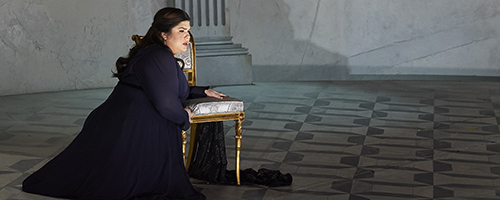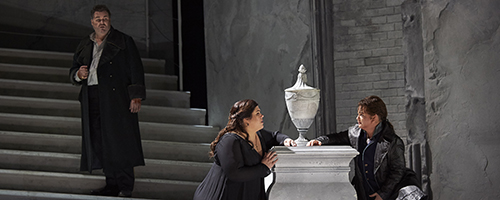-
10 Things to Know: Maometto II
By Gianmarco SegatoPosted in Maometto II
By Gianmarco Segato
1. The real Maometto
The historical Maometto Secondo, or Mehmet II (1432-1481), captured Constantinople in 1453, thus ending the Byzantine Empire. Rossini set his opera in 1470, the year the Venetian colony of Negroponte off the coast of Greece—a trade gateway to the Eastern Mediterranean—was besieged by the Turks. In order to further his plans to invade Western Europe and conquer the Holy Roman Empire, Maometto needed to take Negroponte. Historically, Mehmet was an enlightened ruler, enforcing religious tolerance and freedom in his conquered territories.
2. Rossini in Naples
After his arrival in Naples in 1815, Rossini signed a series of contracts with Neapolitan impresario Domenico Barbaja, and at the remarkably young age of 23 he became musical director of all the city’s theatres, composing new works for them—a post he retained until he left for Paris in 1822. This put Rossini in an ideal position to experiment with new compositional forms, not having to cater to the public’s whims and freeing him from the pressures of seeking out commissions. Also, as Italy’s leading impresario, Barbaja assembled the most accomplished company of singers available at the time for Rossini.
3) Rossini, composer of “serious opera?”
Although perceptions are changing, to this day Rossini is mostly known for his comic operas: The Barber of Seville (1816), La Cenerentola (Cinderella, 1817) and The Italian Girl in Algiers (1813). In reality, the greater portion of his output was opera seria (serious opera). Yet even before his death in 1868, most of these serious works had fallen from the active repertoire. That isn’t to say the works were initially unsuccessful; many enjoyed positive reception and were restaged throughout Italy and in other European centres but disappeared soon thereafter.

4) Ever-changing Maometto II
Until its 2012 revival by Santa Fe Opera, Maometto II had never been performed in its original form, i.e. the version of the score played at the opera’s premiere at Naples’ Teatro di San Carlo on December 3, 1820. Received poorly by the Neapolitan public, Rossini revised the opera extensively for its 1822 Venetian performance, where many of its experimental elements were removed and, most significantly, the ending was changed from tragic to happy. The opera’s final, most radical transformation came in 1826 when Rossini reworked Maometto II into his first French opera, Le Siège de Corinthe, one of the precursors to the French grand opéra form (lavish, five-act pieces utilizing a huge cast and orchestra, plus ballet; usually based on an historical subject).
5) Knocking tradition
Maometto II was experimental, breaking down many of the finely tuned musical and dramatic conventions which Rossini had codified in his earlier operas. Its most striking musical feature is Act I’s 30-minute terzettone (literally, “a big fat trio”) which flows seamlessly from section to section as three of the main characters confront revelations and personal crises despite the temporary departure of two of them, some intrusive cannon fire, an outbreak of group dismay, and a prayer.

6) Born to sing Maometto
Italian bass-baritone Luca Pisaroni sang Maometto in Santa Fe at this production’s premiere in 2012. Pisaroni’s powerful yet agile voice seems tailor-made for the role, embracing both its declamatory, warrior-like passages and its sections of virtuosic coloratura (derived from the Italian “colorare,” meaning “to colour” or “to enliven, coloratura is an ornamental type of vocal music where several notes are sung for each syllable of the text; it’s one of the hallmarks of bel canto opera). Pisaroni recently appeared in the Met HD transmissions of The Enchanted Island (as Caliban) and Don Giovanni (as Leporello).

7) Unconventional soprano lead
The opera’s lead soprano role, Anna, was written by Rossini as a showpiece for his muse, lover, and future wife, Isabella Colbran. By this point in her career, however, her singing abilities were in decline, which, combined with Rossini’s desire for musical reform, meant that the role was not entirely conventional. This is especially true of the Act II finale where in place of the usual, brilliant cabaletta (a relatively short, fiery, up-tempo vocal showpiece), Rossini has the soprano onstage for an uninterrupted 40-minute display of vocal stamina and dramatic artistry. At the COC, Anna will be sung by the exciting, young American soprano Leah Crocetto.
8) David Alden directs
Director David Alden has brought the opera’s action forward from its historical 15th-century setting to the time of its creation in 1820. Alden dubs Maometto II, a “siege opera” but notes it is about war in general, not a specific conflict. He avoids any obvious connections to more contemporary confrontations between east and west.

9) Neoclassical, First Empire style
The simple unit set is a rotunda—a neoclassical colonnade with curved walls which evokes ancient marbled temples. Set and costume designer Jon Morrell has dressed most of the cast in a First Empire-inspired French style suggestive of Rossini’s time, mixing in Napoleonic Grecian revival elements with early 19th-century clothing in striking colours.
10) A new, critical edition of the opera
At the COC, the opera will be presented from a new Critical Edition made available in 2013 by noted music publisher Bärenreiter in cooperation with the Center for Italian Opera Studies at The University of Chicago (the score is a contribution in an ongoing, 20-volume project of The Critical Editions of the Works of Gioachino Rossini). The score was prepared by Dutch scholar Hans Schellevis, who will be in Toronto on Wednesday, April 27, to participate in the COC’s Opera Insights series, where he will discuss the complicated work involved in preparing a score from multiple sources.
To learn more about Maometto II and to buy tickets, click here.
For mobile version, click here.
Photo credits (top - down): Luca Pisaroni as Maometto II (centre); Leah Crocetto as Anna (kneeling); Luca Pisaroni; Leah Crocetto; (l-r) Bruce Sledge as Paolo Erisso, Leah Crocetto as Anna and Elizabeth DeShong as Calbo. Maometto II (COC, 2016), all photos: Michael Cooper
